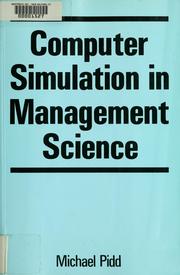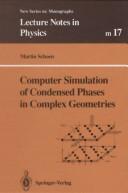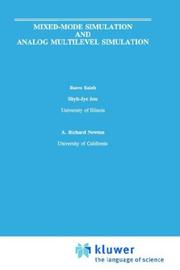| Listing 1 - 10 of 72 | << page >> |
Sort by
|

ISBN: 0471910392 0471902810 9780471902812 9780471910398 Year: 1984 Publisher: Chichester
Abstract | Keywords | Export | Availability | Bookmark
 Loading...
Loading...Choose an application
- Reference Manager
- EndNote
- RefWorks (Direct export to RefWorks)

ISBN: 3540565647 0387565647 3540475907 Year: 1993 Volume: 17 Publisher: Berlin Springer
Abstract | Keywords | Export | Availability | Bookmark
 Loading...
Loading...Choose an application
- Reference Manager
- EndNote
- RefWorks (Direct export to RefWorks)
Book
ISBN: 9783839465806 383946580X Year: 2023 Publisher: Bielefeld
Abstract | Keywords | Export | Availability | Bookmark
 Loading...
Loading...Choose an application
- Reference Manager
- EndNote
- RefWorks (Direct export to RefWorks)
Ever since climate change has been identified as one of the most significant challenges of humanity, climate change deniers have widely tried to discredit the work of scientists. To show how these processes work, Maria M. Sojka examines three ideals about how science should operate. These ideals concern the understanding of uncertainties, the relationship between models and data, and the role of values in science. Their widespread presence in the public understanding of science makes it easy for political and industrial stakeholders to undermine inconvenient research. To address this issue, Sojka analyses the importance of tacit knowledge in scientific practice and the question what defines an expert.
Climatic changes. --- Analytical Philosophy. --- Climate Science. --- Computer Simulations. --- Epistemology. --- Expertise. --- Nature. --- Philosophy of Nature. --- Philosophy. --- Science. --- Society. --- Tacit Knowledge.
Periodical
Abstract | Keywords | Export | Availability | Bookmark
 Loading...
Loading...Choose an application
- Reference Manager
- EndNote
- RefWorks (Direct export to RefWorks)
physics of solid --- liquid and amorphous systems --- phase equilibria and phase transitions --- soft matter --- computer simulations --- Physics --- Condensed Matter Physics --- General and Others --- Magnetism --- Mechanics --- Particle Physics --- Thermodynamics and Heat Transfer
Periodical
Abstract | Keywords | Export | Availability | Bookmark
 Loading...
Loading...Choose an application
- Reference Manager
- EndNote
- RefWorks (Direct export to RefWorks)
Toxicology --- Computational Biology --- Computer Simulation. --- Toxicology. --- Chemicals --- Computerized Models --- In Silico --- Computer Models --- Models, Computer --- Computer Model --- Computer Simulations --- Computerized Model --- In Silicos --- Model, Computer --- Model, Computerized --- Models, Computerized --- Silico, In --- Silicos, In --- Simulation, Computer --- Simulations, Computer --- methods. --- Medicine --- Pharmacology --- Poisoning --- Poisons
Book

ISBN: 9783030912413 Year: 2021 Publisher: Cham Springer International Publishing :Imprint: Springer
Abstract | Keywords | Export | Availability | Bookmark
 Loading...
Loading...Choose an application
- Reference Manager
- EndNote
- RefWorks (Direct export to RefWorks)
Neoplasms. --- Computer Simulation. --- Computerized Models --- In Silico --- Computer Models --- Models, Computer --- Computer Model --- Computer Simulations --- Computerized Model --- In Silicos --- Model, Computer --- Model, Computerized --- Models, Computerized --- Silico, In --- Silicos, In --- Simulation, Computer --- Simulations, Computer --- Benign Neoplasms --- Malignancy --- Malignant Neoplasms --- Neoplasia --- Neoplasm --- Neoplasms, Benign --- Cancer --- Tumors --- Benign Neoplasm --- Cancers --- Malignancies --- Malignant Neoplasm --- Neoplasias --- Neoplasm, Benign --- Neoplasm, Malignant --- Neoplasms, Malignant --- Tumor --- Medical Oncology --- Bioinformatics --- Oncology --- Data processing

ISBN: 0792394739 9780792394730 0792394739 Year: 1994 Publisher: Boston Kluwer Academic
Abstract | Keywords | Export | Availability | Bookmark
 Loading...
Loading...Choose an application
- Reference Manager
- EndNote
- RefWorks (Direct export to RefWorks)
Computer simulation --- Computer Simulation --- Computerized Models --- In Silico --- Computer Models --- Models, Computer --- Computer Model --- Computer Simulations --- Computerized Model --- In Silicos --- Model, Computer --- Model, Computerized --- Models, Computerized --- Silico, In --- Silicos, In --- Simulation, Computer --- Simulations, Computer --- Computer modeling --- Computer models --- Modeling, Computer --- Electromechanical analogies --- Mathematical models --- Simulation methods --- Model-integrated computing --- Circuits
Book
ISBN: 3642370020 3642370039 1306542480 Year: 2014 Publisher: Heidelberg [Germany] : Springer,
Abstract | Keywords | Export | Availability | Bookmark
 Loading...
Loading...Choose an application
- Reference Manager
- EndNote
- RefWorks (Direct export to RefWorks)
This book presents up-to-date knowledge of dynamic analysis in engineering world. To facilitate the understanding of the topics by readers with various backgrounds, general principles are linked to their applications from different angles. Special interesting topics such as statistics of motions and loading, damping modeling and measurement, nonlinear dynamics, fatigue assessment, vibration and buckling under axial loading, structural health monitoring, human body vibrations, and vehicle-structure interactions etc., are also presented. The target readers include industry professionals in civil, marine and mechanical engineering, as well as researchers and students in this area.
Competition -- Computer simulations. --- Computer-aided engineering -- Mathematics. --- Industrial organization (Economic theory) -- Computer simulations. --- Structural dynamics -- Mathematics. --- Civil & Environmental Engineering --- Engineering & Applied Sciences --- Operations Research --- System analysis. --- Network theory --- Systems analysis --- Engineering. --- Computer mathematics. --- Vibration. --- Dynamical systems. --- Dynamics. --- Mechanical engineering. --- Aerospace engineering. --- Astronautics. --- Civil engineering. --- Vibration, Dynamical Systems, Control. --- Aerospace Technology and Astronautics. --- Computational Science and Engineering. --- Civil Engineering. --- Mechanical Engineering. --- Engineering --- Public works --- Space sciences --- Aeronautics --- Astrodynamics --- Space flight --- Space vehicles --- Aeronautical engineering --- Astronautics --- Engineering, Mechanical --- Machinery --- Steam engineering --- Dynamical systems --- Kinetics --- Mathematics --- Mechanics, Analytic --- Force and energy --- Mechanics --- Physics --- Statics --- Cycles --- Sound --- Computer mathematics --- Discrete mathematics --- Electronic data processing --- Construction --- Industrial arts --- Technology --- Network analysis --- Network science --- System theory --- Mathematical optimization --- Computer science. --- Informatics --- Science
Book
Year: 2022 Publisher: Basel MDPI Books
Abstract | Keywords | Export | Availability | Bookmark
 Loading...
Loading...Choose an application
- Reference Manager
- EndNote
- RefWorks (Direct export to RefWorks)
With the Internet of Things and various information and communication technologies, a city can manage its assets in a smarter way, constituting the urban development vision of a smart city. This facilitates a more efficient use of physical infrastructure and encourages citizen participation. Smart energy and smart mobility are among the key aspects of the smart city, in which the electric vehicle (EV) is believed to take a key role. EVs are powered by various energy sources or the electricity grid. With proper scheduling, a large fleet of EVs can be charged from charging stations and parking infrastructures. Although the battery capacity of a single EV is small, an aggregation of EVs can perform as a significant power source or load, constituting a vehicle-to-grid (V2G) system. Besides acquiring energy from the grid, in V2G, EVs can also support the grid by providing various demand response and auxiliary services. Thanks to this, we can reduce our reliance on fossil fuels and utilize the renewable energy more effectively. This Special Issue “Smart Energy and Intelligent Transportation Systems” addresses existing knowledge gaps and advances smart energy and mobility. It consists of five peer-reviewed papers that cover a range of subjects and applications related to smart energy and transportation.
Technology: general issues --- History of engineering & technology --- electric vehicles --- PROSA --- PROMETHEE for Sustainability Assessment --- MCDA --- Multi-Criteria Decision Analysis --- stochastic analysis --- Monte Carlo --- uncertainty --- cargo bicycles --- loading hub --- facility location problem --- computer simulations --- Python programing --- electric vehicle charging --- vehicle-to-grid --- genetic algorithms --- particle swarm optimization --- demand-side management --- discrete choice theory --- revenue management --- road-railway accidents --- classification trees --- road safety --- transport means --- accidents victims --- condition monitoring --- vibroacoustic diagnostics --- gearbox --- power transmission systems --- neural networks --- deep learning --- electric vehicles --- PROSA --- PROMETHEE for Sustainability Assessment --- MCDA --- Multi-Criteria Decision Analysis --- stochastic analysis --- Monte Carlo --- uncertainty --- cargo bicycles --- loading hub --- facility location problem --- computer simulations --- Python programing --- electric vehicle charging --- vehicle-to-grid --- genetic algorithms --- particle swarm optimization --- demand-side management --- discrete choice theory --- revenue management --- road-railway accidents --- classification trees --- road safety --- transport means --- accidents victims --- condition monitoring --- vibroacoustic diagnostics --- gearbox --- power transmission systems --- neural networks --- deep learning
Book
ISBN: 1430263385 1430263377 1322131880 Year: 2014 Publisher: Berkeley, CA : Apress : Imprint: Apress,
Abstract | Keywords | Export | Availability | Bookmark
 Loading...
Loading...Choose an application
- Reference Manager
- EndNote
- RefWorks (Direct export to RefWorks)
Have you ever wanted to include believable physical behaviors in your games and projects to give them that extra edge? Physics for JavaScript Games, Animation, and Simulations teaches you how to incorporate real physics, such as gravity, friction, and buoyancy, into your HTML5 games, animations, and simulations. It also includes more advanced topics, such as particle systems, which are essential for creating effects such as sparks or smoke. The book also addresses the key issue of balancing accuracy and simplicity in your games and simulations, and the final chapters provide you with the information and the code to make the right choice for your project. Physics for JavaScript Games, Animation, and Simulations assumes you have a basic knowledge of JavaScript and HTML5. However, no previous knowledge of physics is required—only some very basic math skills. The authors present everything from basic principles to advanced concepts in an approachable way, so you’ll be able to follow the logic and easily adapt the principles to your own applications. The book is packed full of practical examples of how you can apply physics to your own games and applications. Spring behaviors can be used for anything from tweaking lowrider suspension to creating cloth simulation; flotation mechanics enable the simulation of submersibles or dirigibles; you can even create your own solar system with accurate orbits and gravity. It doesn’t matter if you’re modeling the Lorentz force in an electromagnetic field or you’re modeling the lift force in a flight simulator, Physics for JavaScript Games, Animation, and Simulations enables you to fill your games and applications with accurate and realistic effects.
Physics --- Computer games --- JavaScript (Computer program language) --- HTML (Document markup language) --- Computer simulations. --- Programming. --- Domain-specific programming languages --- Object-oriented programming languages --- Scripting languages (Computer science) --- Computer game programming --- Game programming (Computer games) --- Computer programming --- Natural philosophy --- Philosophy, Natural --- Physical sciences --- Dynamics --- HyperText Markup Language (Document markup language) --- Document markup languages --- Computer games—Programming. --- Software engineering. --- Game Development. --- Software Engineering/Programming and Operating Systems. --- Computer software engineering --- Engineering
| Listing 1 - 10 of 72 | << page >> |
Sort by
|

 Search
Search Feedback
Feedback About UniCat
About UniCat  Help
Help News
News